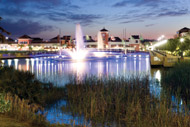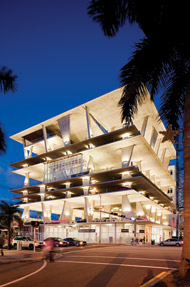|
COVER STORY, AUGUST 2011
SUN SHINES ON FLORIDA RETAIL
The Florida retail market is seeing increased activity.
Savannah Duncan
As the second quarter of 2011 comes to a close, many markets in Florida are seeing signs of positive improvement in the retail sector. Leasing activity has accelerated, especially with fast-casual restaurants, grocery and value retailers taking space, and “A” centers are filling up. In some lease negotiations, landlords have been able to start firming up, but in others, tenants remain in control. Although there is not much new development of shopping centers and malls, there are a few mixed-use properties with retail space, freestanding retail stores and redevelopments in progress. On the whole, there is a sense of cautious optimism that the retail market has steadily started heating up again.
“The retail market overall is definitely better than it was in 2011,” says Cindy Frank, vice president of retail for Jones Lang LaSalle’s Fort Lauderdale, Florida, office. “We’re seeing positive trends both in job growth and lowered unemployment. It’s a slope of steady recovery for Florida, which was hit hard by the recession.”
Southeast Real Estate Business checked in with retail professionals from north to south and east to west across Florida to gauge the state of retail, breaking down the current climate market by market.
Northeast Florida
National retailers are starting to make deals again, and some tenants are even looking to enter the Northeast Florida market for the first time, says Carrie Smith, senior director of Franklin Street Real Estate Services’ Jacksonville, Florida, office. Fast-casual restaurants and specialty food businesses, such as frozen yogurt and cupcake shops, have been especially active in Jacksonville.
“Restaurants are a big push, especially for prime retail,” says Steve Weingarten, senior vice president of leasing of Weingarten Realty’s Jacksonville office.
“National retailers are back in the game,” adds John Joyce, principal of Jacksonville-based Joyce Development Group. “They are out there and they are leasing space.”
One center that has continued to attract new tenants to remain fully leased is the 1.23 million-square-foot St. Johns Town Center, says James Morgan, managing director of Sperry Van Ness’ Jacksonville office.
Smith says “A” and “B” centers have maintained relatively good occupancy and vacancy rates, while the “C” centers struggled more. “In ‘C’ centers, rental rates have dropped off significantly,” she says.
Weingarten says landlords and tenants are willing to work together to make a deal, especially in the “A” centers. “The strong retailers are aware that prime space is harder to obtain due to the lack of new development,” he says.
Smith agrees that instead of Jacksonville being a “tenant’s market,” there is more compromise occurring. “In January, we started see both sides come to the middle,” she adds. “Halfway through the year, it has remained the same; there’s a lot more give-and-take deals. Twelve months from now, we’ll be back in a position where landlords will be turning away deals because retailers will be fighting for the same spots.”
Given the lack of new development in the area, Smith’s prediction about tenants fighting for space is definitely a viable one. A lot of the big box spaces are being leased, and eventually there will only be a limited amount of space available, says Weingarten.
“The attitude is positive because something is being done,” adds Joyce. “We haven’t returned to the economies of the 2005 to 2006 period, but at least we are doing more than we were doing last year. It’s going to be slow and steady for at least the next 24 to 36 months.”
Central Florida
Like other parts of Florida, discount chains, restaurants and grocery stores make up the majority of the retail activity in Central Florida. John Crossman, president of Orlando-based Crossman & Co., points to Publix as one of the most aggressive buyers of retail property.
However, Bartow McDonald, managing director of Sperry Van Ness’ Ocala, Florida, office, says he has seen some activity not only with national and regional retailers, but also with locally owned businesses.
“During the last 50 days, we have started to see mom-and-pop retailers come back in the marketplace,” McDonald says. “We are really encouraged that local entrepreneurs are taking the initiative to start businesses and re-engage the economy.”
David Conn, executive vice president of CB Richard Ellis’ Tampa office, says that although some national retailers like Sam’s Club and Walmart are constructing new, free-standing properties, development of sizable power centers is still a few years away. He predicts that around 2013 some new construction could begin to occur.
Mitchell Rice, president of Tampa-based RMC Property Group, says ground-up development is still a challenge now, in part because financing is hard to obtain. Also, he says retail built ahead of residential growth, so when the residential market stopped growing, it had a corresponding effect on retail.
There are, however, large-scale projects occurring that have been drawing retailers to specific areas. For example, David Barilla, economic development coordinator of Downtown Orlando, says the new 875,000-square-foot Amway Center, which opened in October 2010, has pulled about 65 new retailers and restaurants to downtown Orlando.
Gary Ralston of Lakeland, Florida-based Coldwell Banker Commercial Saunders Ralston Dantzler Realty, predicts that the LEGOLAND opening in Winter Haven, Florida, in October could potentially draw restaurant owners and retailers to that area as well.
Like in Northeast Florida, the “A” and “B” centers are seeing a significant amount of leasing activity, says Brian Bern, senior director of Franklin Street Real Estate Services’ Tampa office.
“It looks to me like we’re at the bottom of the retail cycle, and with the lack of new development, in the future we should see positive growth and positive absorption,” adds Robin Webb, managing director of Coldwell Banker Commercial NRT’s Maitland, Florida, office.
Conn predicts that in the next year, competition for available space in Central Florida will continue to rise, which will have a corresponding effect on rent.
“You will see rents increasing here as a result of a lack of development and the continuing absorption of space,” he says.
Southeast Florida
The retail markets in Southeast Florida are starting to see full-on recovery.
“Fort Lauderdale is very similar to what we are seeing in all of South Florida in that the market is slightly better; both landlords and retailers are still cautious and moving forward slowly,” says Patricia Nooney, senior managing director of asset services of CB Richard Ellis’s Fort Lauderdale office.
“In Miami, specifically Dade County, retail has rebounded significantly and we’ve seen a tremendous amount of deal velocity in the last 12 months, significantly more than the past couple of years,” says Jason Press, senior retail associate of Coral Gables, Florida-based Continental Real Estates Cos. “Much of the big box space in Dade County is gone. While rents have fallen, most of the vacancy has been absorbed, and in a very short period of time. Eighteen to 24 months ago, if you were a tenant you had your pick of what you wanted, and now it’s a really tight market again.”
Paco Diaz, senior vice president of CB Richard Ellis’ Miami office agrees. “Everybody wants to come back,” he says. “The issue is who can find the space they are looking for.”
“If you look at Lincoln Road [in Miami], we are seeing a lot of high-end retailers entering the market that you would find in Manhattan,” says Adam Lustig, partner of Miami-based Bilzin Sumberg Baena Price & Axelrod. “In particular, we are seeing retailers who haven’t been previously in Miami, and in some cases, haven’t opened stores outside of New York.”
Cindy Frank of Jones Lang LaSalle says that in addition to luxury stores entering the market, she has also seen other retailers expanding in Southeast Florida. H&M will make its Miami debut in 2012, and hhgregg recently opened 10 new stores in south Florida. Additionally, Chase Bank announced in April that during 2011, 37 Florida branches would open.
Because barriers to entry and cost to entry are prohibitive, there is minimal new construction, says Larkin.
 |
Phase II of the redevelopment of The Palms at Town & Country in Miami is under construction.
|
|
Peter Schlang, director of leasing of Boca Raton, Florida-based Woolbright Development, says that once land prices start to come down, he thinks there will be some select development.
“While people will start to plan new projects soon, from start to finish it can take as long as 3 years,” he says. “There won’t be any new product available in the next 12 to 24 months. This might give us the opportunity for well-located space to be renovated.”
One project that has been able to move forward is the re-development of the 700,000-square-foot Palms at Town & Country, owned by TIAA-CREF, in Miami. Phase I, which was completed in May 2010, contains 300,000 square feet including a 94,940-square-foot Kohl’s and a 34,821 Nordstrom Rack. Full completion is scheduled for 2013.
 |
The mixed-use development 11 11 Lincoln Road in Miami added 40,000 square feet of retail space.
|
|
In Miami, the 150,000-square-foot mixed-use development 11 11 Lincoln Road, which included 40,000 square feet of retail space, opened in 2010. The property encompasses office, retail, restaurant and living space. The fully leased retail space includes Rosa Mexicano, Taschen Books, Y-3, Mac Cosmetics, Nespresso, Shake Shack and Juicy Couture.
“Assuming the economy continues to improve slightly, South Florida will see continued absorption of vacancy, a small increase in rent and continued growth of retailers, especially those entering the market for the first time,” Larkin says. “We are definitely on everybody’s radar screen.”
Looking ahead
Crossman says that during the next six months to a year, there is still a lot of opportunity for retailers to continue to do business in Florida.
“There are a lot of really interesting opportunities right now for a lot of different companies, retailers, owners and brokers,” he says. “Having said that, it’s going to require a lot of hard work. Nothing is going to come simple or easy, but this is an opportunity for people to work hard and work together.”
Though each area of Florida varies slightly, the same kinds of retail are making up the majority of the growth. There isn’t a lot of new development on the horizon, but some mixed-use projects are adding some retail space. The most important similarity is the belief that from here, retail real estate will continue to improve.
©2011 France Publications, Inc. Duplication
or reproduction of this article not permitted without authorization
from France Publications, Inc. For information on reprints
of this article contact Barbara
Sherer at (630) 554-6054.
|
